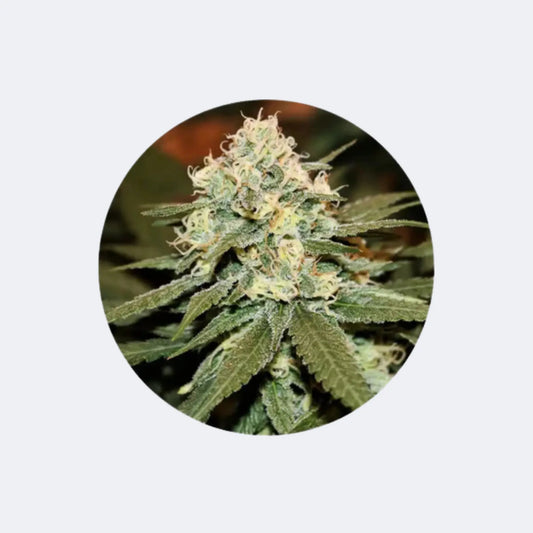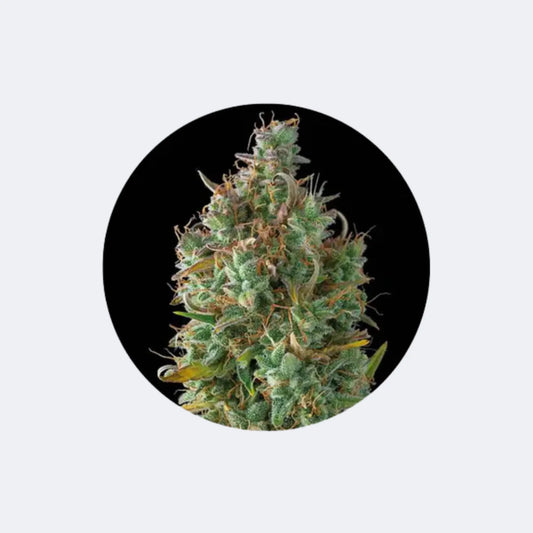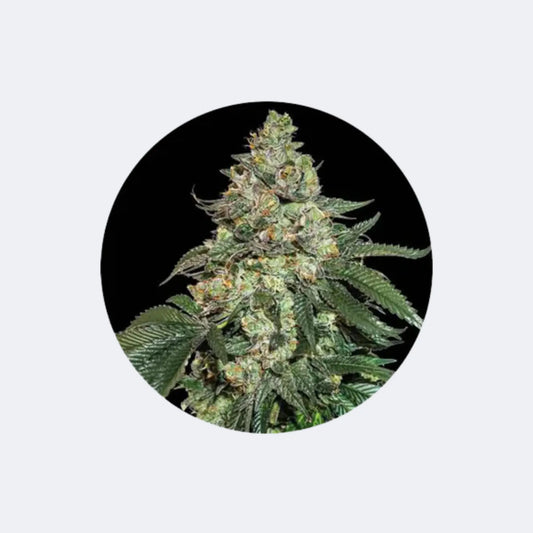
Accelerate the veggie and flowering phase of weed
Andreas LeschkeShare blog post
How to put your cannabis plants in pole position for faster harvest.
Basically, in this blog post, I would like to point out that even if it is possible to push your beloved marijuana plants to harvest faster, this will not be possible without sacrificing quantity (yield) and, depending on the method, quality.
If you want to achieve perfect bud results, you can skip reading this blog post, as it is intended for people who are willing to sacrifice quantity and possibly quality in order to harvest faster.
Whether it's due to impatience or lack of time, because you suddenly have to leave and no longer have time to let the plants grow to completion, it doesn't matter to me as a blogger, because my goal is to provide you, interested grindgrass growers, with as much information as possible so that everyone can choose the best option for their own growing career.
Although there are various ways to speed up the growth and flowering phases, both with automatics and photoperiod genetics, I will first discuss a few basics that you should follow if you have already set your sights on harvesting the buds as quickly as possible before the seeds germinate.

1. Choose the right genetics
If you want fast results right from the start, automatics are a must. While you can shorten the vegetative and flowering phases of photoperiod genetics with a few tricks, this is not recommended, as the yields will remain below those possible with automatics, which are so popular for their short life cycle and excellent yields.
If you want it even faster, you should choose the genetics known as fastflowers, which require a flowering time of a maximum of 8 weeks.
If you want to make it easier for yourself to find the right genetics to start a turbo grow, you can read my blog post:
"Harvest six times a year"
Get all the information you need to harvest every two months!
If you don't want to read this article and would like to find out for yourself which genetics are suitable for faster harvests, you should keep in mind that "Indica" dominant genetics usually require 1/3 less time to flower than "Sativa" dominant strains.
2. Repotting prohibited
Any repotting takes time for the plants to recover because it stresses them. Therefore, either the seedling should be placed directly into the final pot or the seed should be allowed to germinate in the final pot.
Due to the fact that faster growth and the resulting shortened lifespan of the cannabis plants means that you cannot cultivate huge plants and therefore lower yields are inevitable from the start, the final pot should not be too large, so 5 to 10 liters are more than sufficient!
3. Don't train the plants
Any HST or LST methods are taboo. Even the slightest training results in short growth interruptions during which the plant needs to recover. Anyone who wants to harvest their plants as successfully and as quickly as possible should be aware that topping, fimming, supercropping, and other HST skills are just as counterproductive as mild stress, such as that caused by lollipops.
Instead of lollipopping, where you defoliate your plants, fold down only the leaves that block the plant's light and secure them with string or plant ties. This achieves almost the same effect as defoliation, but without the plant ceasing its growth to recover.
4. Start with soil that is not pre-fertilized
Especially at the beginning, it is extremely important for explosive and rapid growth to choose a soil that contains few nutrients.
This encourages the plant to form roots faster, which is beneficial for growth. After about two weeks, the soil should be fertilized for the first time with a vegetable fertilizer to balance the nutrient content.
5. Use cuttings instead of seeds (only works with photoperiod plants)
If you decide to use photoperiod genetics despite the advantages of autoflowering genetics and want to harvest them more quickly, you should take cuttings from a mother plant instead of germinating seeds.
This skips the time until a seed reaches approximately the same size as a cutting.
How to obtain cuttings that are guaranteed to root quickly can be found in my blog post:
"Taking cuttings from mother plants"
can be read.
These "basics" can save a lot of time, allowing us to achieve successful harvests faster. However, there are still a few methods and tricks you can use during the veggie and flowering phases to further accelerate the grow, which I'll now introduce to you:
1. Use a longer light duration in the veggie phase for automatics:
Typically, our cannabis plants are exposed to at least 16 to 18 hours of light per day during the vegetative phase.
In my blog post, where I examined the different parent genetics, such as Indica, Sativa and Ruderalis, I already explained that Cannabis Ruderalis grows in regions where the sun shines 24 hours a day.
We can apply this knowledge to our plants by giving our automatics 24 hours a day for the first 6 weeks, but reducing the light intensity to 70% (either dimming or raising the light).
A photoperiod lady would certainly be overwhelmed by 24/7 light and would begin to stress. This is NOT the case with Ruderalis. The plants are genetically engineered to endure 24 hours without ceasing growth. On the contrary, they will actually grow faster and more if they receive longer light!
2. Force your automatic to flower faster
Automatics are able to flower independently after a few weeks with a constant light duration of 18 - 24 hours of light per day.
Nevertheless, all automatics contain at least one of the two mother genetics "Sativa" or "Indica", which have stored in their gene database the knowledge to flower with a light duration of 12 hours.
The skilled ganja gardener can take advantage of this to determine whether to push their automatic plants into flowering earlier. To do this, adjust the light duration to 10 to a maximum of 12 hours per day. A few days later, they will already be in pre-flowering. Once the plant is in pre-flowering, the light can be increased again to 12 to 13 hours and turned up to full power.
There are two important things to keep in mind when doing this. Even though the automatics receive less light during flowering, but with higher intensity, they will still continue to grow during the first third of flowering, so they can reach at least twice as tall, and in some cases even three times as tall as before flowering!
Once the plant realizes it's only receiving 12 hours of light per day, it will perceive this as a signal to resume flowering. Increasing the light duration now could tell the sativa or indica genes that spring is just around the corner and encourage the plant to ripen its flowers more quickly in order to return to the vegetative phase.
The risk of ruining the harvest by increasing the light too early would be too high. Therefore, I recommend keeping the light to a maximum of 12 to 13 hours per day to avoid unnecessarily disrupting the plants' hormonal balance. At least until the time when the buds swell most explosively is over, which usually ends 3-4 weeks before the end of the flowering phase.
3. Force your autos to ripen faster after the blossoms swell.
Typically, after the plant's stretch phase, where it has grown even further in height, the buds visibly swell. Once this phase is over, the Cheshire grass lady focuses primarily on ripening.
If we keep the light at 12 hours, the plant will "think" it's still in the depths of autumn and has plenty of time to ripen. If the light hours were to slowly but steadily increase per day, the ganja girl would realize that spring is approaching and start ripening the buds faster so she can enter the vegetative phase again.
Those in a hurry to harvest faster can take advantage of this knowledge by gradually increasing the light duration. I once did this with a "Mango Smile Automatic" plant: within six days, by increasing the timer by one hour daily, the lady was back to 18 hours of light.
After the light shone on the lovely girl again for 18 hours, not only did the buds visibly swell even further, but the trichomes ripened within 8 days, so I was able to shorten the harvest time by 14 days.
However, some "side effects" were also noticeable. After this time change from 12 hours to 18 hours within six days, the lady developed a rapid cal/mag deficiency. The stigmas (the white hairs on the buds) didn't manage to darken during this time, which I had to accept.
4. Force your weed ladies to mature faster by depriving them of nutrients
Throughout the flowering phase, our grass ladies primarily require phosphorus, potassium, and also nitrogen. Depriving the plants of these nutrients will force them to quickly complete their ripening process before the required nutrients are no longer available.
With this method, weed growers begin to slowly deprive their plants of nutrients during the last two weeks of flowering. Please note that too rapid or radical nutrient deprivation can also lead to hermaphroditism.
Personally, I deprive my plants of nutrients by starting with the first five days of bud swelling, when I only feed them two-thirds of the previous daily amount of fertilizer. For the next five days, I feed them about one-third of the usual amount of fertilizer, and for the last four days, I only flush the soil with water. This way, I achieve faster trichome maturation.
With this method, the flowering period can be shortened by one to two weeks (depending on genetics).
5. Shorten flowering time through targeted stress
Even though I don't think much of this method, I still have to briefly touch on it because it's also a method for shortening the flowering period. Inducing stress during the flowering phase can also force the plants to bloom more quickly. There are various methods used for this, including repeated temperature changes (always within a range of 21-26°C), water deprivation, light deprivation (turning off light for 24 hours), or even targeted nutrient deprivation. For example, a phosphorus deficiency causes enough stress to accelerate the flowering period.
However, this method also carries a significant risk that the plants will start to hermaphroditic, or if overdone, even suffer significant yield losses. Therefore, I would advise against such methods entirely.
Closing words:
Shortening the flowering period certainly brings with it disadvantages, such as lower yields or, depending on the method, lower quality. However, even with these methods, yields and quality can be boosted by using pre-flowering boosters such as honey (a post on this will follow soon) or foliar sprays.
We thank the author Jorge Rieger for this blog post on the topic of "Speeding Up the Veggie and Flowering Phase of Weed." Feel free to follow him on his Facebook account. --> Click here






